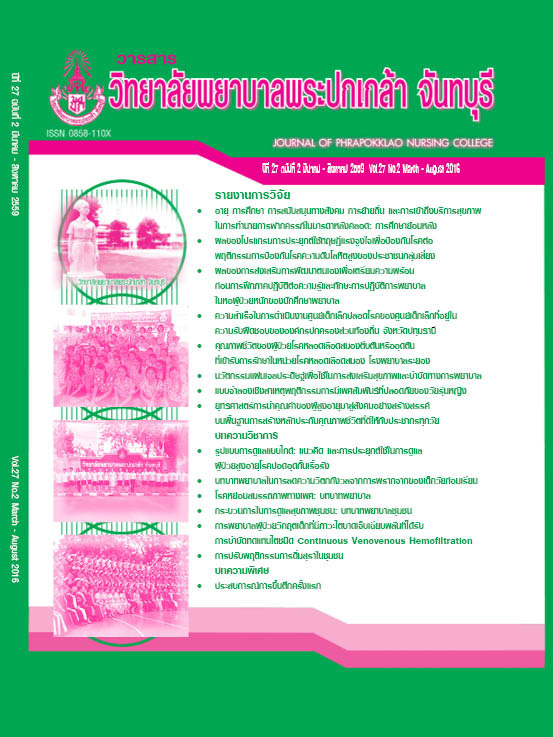The Innovation of Invented Gel Pad for Use in Health Promotion and Nursing Therapeutic
Keywords:
Innovation, Invented gel padAbstract
This study is laboratory experiment which aimed to invent an effective gel pad which is effectively equivalent to the standard gel pad with low production cost and can be made available by health services. The research instruments included synthetic polymer fibers and water, the equipment for invention, for the temperature test, for compress making, and for the comparison of properties, the record of the gel pad’s temperature, and the record of the temperature of the tissue. The study and the data collection were conducted from May to September, 2014. The processes of the study included: 1) the literature reviews on searching for the properties and safety materials to invent gel pad, 2) testing on the elements and proportions of appropriate materials to invent gel pad, 3) testing on performance method for preparing gel pad, 4) testing on temperature reserve and confinement period between the invented gel pad and the standard gel pad, 5) testing on the performance of the gel pad when doing warm compress on the tissues of two female volunteers and 6) experimenting for the effectiveness on the gel pad when doing warm compress. The data were analyzed by frequency and mean.
The results of the study revealed that the invented gel pad can be made from synthetic polymer fibers in finished diapers baby by mixing 60 ml. of pure water into 1 gram of synthetic polymer. The preparation of the gel pad can be done by soaking gel pad in boiling water for at least 5 minutes. The suitable gel pad for use was 3-4 grams. It was found that the invented gel pad was effectively equivalent in reserving temperature to the standard gel pad. The invented gel pad compress of 4 grams was suitable for warm compress. It did not cause irritation to the tissues. It was also found that the invented gel pad can be used 9 times, with an average cost of 13 satang each time.
According to this study, it is recommended that the health services can use the invented gel pad in health promotion and nursing therapeutic without the constraint of budget.
References
นริชชญา หาดแก้ว, และปราณี ธีรโสภณ. (2558). ผลของการประคบเย็นด้วยแผ่นเจลโพลิเมอร์ ต่อความเจ็บปวดแผลฝีเย็บหลังคลอด. วารสารวิทยาลัยพยาบาลพระปกเกล้า จันทบุรี, 26(เพิ่มเติม 1), 1-13.
นิตยา พันธ์งาม, ปราณี ธีรโสภณ, และสุพรรณี อึ้งปัญสัตวงศ์. (2559). ผลของการประคบเต้านมด้วยลูกประคบเจลโพลิเมอร์แบบอุ่นชื้นต่อระยะเวลาการหลั่งน้ำนมครั้งแรกในมารดาหลังคลอดครรภ์แรก. วารสารวิทยาลัยพยาบาลพระปกเกล้า จันทบุรี, 27(1), 28-38.
Amir, L. H., Jones, L. E., & Buck, M. L. (2015). Nipple pain associated with breastfeeding: Incorporating current neurophysiology into clinical reasoning [online]. Australian Family Physician, 44(3), 127-132. Retrieved January 16, 2016, from http://search.informit.com.au/documentSummary;dn=977141461891470;res=IELHEA>ISSN:0300-8495
Chandler, A., Preece, J., & Lister, S. (2002). Using heat therapy for pain management. Nursing Standard, 17(9), 40-42.
Dey, S., Helmes, C. T., White, J. C., & Zhou, S. (2014). Safety of disposable diaper materials: Extensive evaluations validate use. Clinical Pediatrics, 53(suppl. 9), s17-s19.
Dube, J. (2013). Effect of application of ice on episiotomy. Asian Journal of Nursing Education and Research, 3(4), 207-210.
Joy, M. C., & Hsu, W.-N. (2009). Superabsorbent polymer having increased rate of water absorption (United States Patent 7,615,579). Retrieved August 4, 2016, from http://patents.com/us-7615579.html
Kabiri, K., Omidian, H., Zohuriaan-Mehr, M. J., & Doroudiani, S. (2011). Superabsorbent hydrogel composites and nanocomposites: A review. Polymer Composites, 32(2), 277-289.
Kent, J. C., Prime, D. K., & Garbin, C. P. (2012). Principles for maintaining or increasing breast milk production. Journal of Obstetric, Gynecologic & Neonatal Nursing, 41(1), 114-121.
Mooventhan, A., & Nivethitha, L. (2014). Scientific evidence-based effects of hydrotherapy on various systems of the body. North American Journal of Medical Sciences, 6(5), 199-209.
Nurcan, Ç., & Karadag, M. (2015). Superficial heat and cold applications in the treatment of knee osteoarthritis. Retrieved January 16, 2016, from http://dx.doi.org/10.5772/60534
Purwaningsih, A. A., Rahayu, H. S. E., & Wijayanti, K. (2015). Effectiveness of warm compress and cold compress to reduce laceration perineum pain on primiparous at Candimulyo Magelang 2015. International Journal of Research in Medical Sciences, 3(suppl. 1), s24-s29.
Shanmugasundaram, O. L., & Mahendra Gowda, R. V. (2010). Development and characterization of bamboo and organic cotton fibre blended baby diapers. Indian Journal of Fibre & Textile Research, 35(3), 201-205.
Watkins, A. A., et al. (2014). Ice packs reduce postoperative midline incision pain and narcotic use: A randomized controlled trial. Journal of the American College of Surgeons, 219(3), 511-517.
Zuppa, A. A., et al. (2010). Safety and efficacy of galactogogues: Substances that induce, maintain and increase breast milk production. Journal of Pharmacy & Pharmaceutical Sciences, 13(2), 162-174.
Downloads
Published
How to Cite
Issue
Section
License
Copyright (c) 2016 Journal of Phrapokklao Nursing College

This work is licensed under a Creative Commons Attribution-NonCommercial-NoDerivatives 4.0 International License.
เนื้อความ ข้อมูล และรายการอ้างอิงที่ผู้เขียนใช้ในการเขียนบทความเพื่อลงตีพิมพ์ในวารสารวิทยาลัยพยาบาลพระปกเกล้า จันทบุรี ถือเป็นความคิดเห็นและความรับผิดชอบของผู้เขียน คณะผู้จัดทำวารสารไม่จำเป็นต้องเห็นพ้องด้วยหรือร่วมรับผิดชอบ
บทความที่ได้รับการลงตีพิมพ์ในวารสารวิทยาลัยพยาบาลพระปกเกล้า จันทบุรี ถือเป็นลิขสิทธิ์ของวารสารวิทยาลัยพยาบาลพระปกเกล้า จันทบุรี หากหน่วยงานหรือบุคคลใดต้องการนำส่วนหนึ่งหรือทั้งหมดของบทความไปเผยแพร่ต่อเพื่อวัตถุประสงค์ใด ๆ จะต้องได้รับอนุญาตจากบรรณาธิการวารสารก่อน



